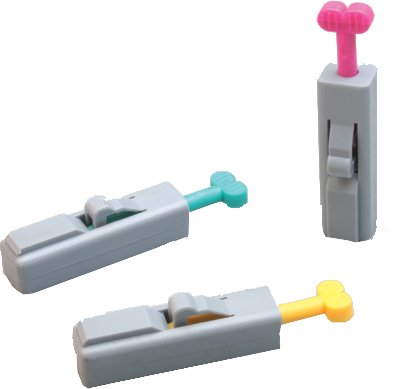
Safety Blood Lancet
Safety Lancets are a safe and convenient way to sample blood. They work by using a lancet tip that pierces the skin and then retracts, sealing the puncture site and preventing any contact with the blade.
| Ref. No.: | Description: | Gauge/Depth: |
|---|---|---|
| NME000401 | Pink (Junior) | 26G/1.8mm |
| NME000403 | Green (Comfort) | 23G/2.4mm |
| NME000404 | Orange (Extra) | 21G/2.4mm |
Safety lancets are devices used to puncture the skin and obtain a small blood sample. They are typically used for fingersticks, but can also be used on other body parts such as the earlobe or forearm. Safety lancets have a number of advantages over conventional lancets. First, they are much sharper, which minimizes pain and trauma to the skin. Second, they are designed to retract after use, so there is no risk of accidentally sticking yourself with the lancet. Third, they often come with built-in safety features such as a guard that covers the sharp tip after use. If you are planning on fingerstick sampling, safety lancets are the safest and most convenient option.
If you're wondering how to use safety lancets, the process is actually quite simple. First, you'll need to gather all of the necessary supplies. You'll need a safety lancet, gloves, alcohol wipes, and gauze. Once you have all of your supplies, wash your hands thoroughly with soap and water. Dry them off completely before proceeding. Next, put on a pair of gloves. It's important to keep everything as clean as possible to avoid infection. Using an alcohol wipe, clean the area where you'll be puncturing the skin. Allow the area to air dry for a moment before moving on. Now it's time to actually use the safety lancet. Place the point of the lancet against your skin and press down firmly. The lancet will automatically puncture your skin and retract back into the device. You may feel a slight prick when this happens. Once the lancet has retracted, remove it from your skin and dispose of it properly. Apply pressure to the puncture site with a piece of gauze to stop any bleeding. You can then proceed with whatever blood sampling procedure you were planning on doing.
There are many benefits of using safety lancets. First, they are much safer than traditional lancets. With traditional lancets, there is a risk of the needle becoming contaminated with blood and causing an infection. With safety lancets, the needle is automatically retracted after use, so there is no risk of contamination. Second, safety lancets are more convenient than traditional lancets. Traditional lancets require you to manually push the needle into your skin. With safety lancets, the needle is automatically injected into your skin, so you don't have to worry about doing it yourself. Third, safety lancets are less painful than traditional lancets. The needles used in traditional lancets are often much larger than those used in safety lancets. This means that they can cause more pain when they're injected into your skin. Fourth, safety lancets are more accurate than traditional lancets. When you use a traditional Lancet, there is a risk of the needle going into your skin at an angle and not piercing the vein correctly. This can cause pain and bruising. With safety Lancets, the needles are always inserted at a 90-degree angle, so there is no risk of inaccurate punctures. Overall,safety LancETS offer many advantages over traditional LancETS. They're safer, more convenient, less painful, and more accurate.
There are several types of needles that can be used to collect a blood sample, but safety lancets are by far the safest and most convenient option. Lancets are small, disposable needles that are used to puncture the skin and collect a small amount of blood. Unlike other types of needles, lancets do not require a needle stick cover or any other type of safety device. This makes them much easier to use and less likely to cause accidental needle sticks. Lancets are also much sharper than other types of needles, which makes them less painful to use. And because they are so small, they cause very little tissue damage. Other types of needles, such as butterfly needles, can be more painful to use and can cause more tissue damage. Safety lancets are available in a variety of sizes and shapes to fit different needs. They can be used with finger-stick devices or lancing devices. And they can be purchased with or without a safety guard. No matter what your needs, there is a safety lancet that is right for you.
If you're looking for alternatives to using safety lancets, there are a few options available. One alternative is to use a fingerstick device. Fingerstick devices are designed to puncture the skin and collect a small sample of blood without causing much pain. Another alternative is to use a venipuncture kit. Venipuncture kits include everything you need to collect a blood sample from a vein, including a needle and syringe. If you're not comfortable with either of these options, you can always ask your healthcare provider to collect a sample of your blood.